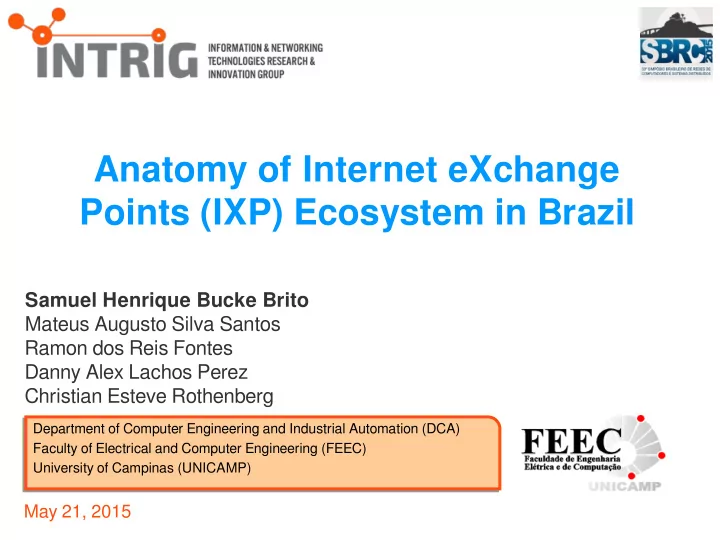

Anatomy of Internet eXchange Points (IXP) Ecosystem in Brazil Samuel Henrique Bucke Brito Mateus Augusto Silva Santos Ramon dos Reis Fontes Danny Alex Lachos Perez Christian Esteve Rothenberg Department of Computer Engineering and Industrial Automation (DCA) Department of Computer Engineering and Industrial Automation (DCA) Faculty of Electrical and Computer Engineering (FEEC) Faculty of Electrical and Computer Engineering (FEEC) University of Campinas (UNICAMP) University of Campinas (UNICAMP) May 21, 2015
Agenda 02 Introduction and Background Methodology Analysis and Results Conclusion Future Work
What Are IXPs? 03 A neutral-carrier infrastructure Host the interconnection of many ASes Provides a layer-2 switch fabric for its members Allow bilateral agreements through direct connections Allow multilateral agreements through route-servers Improve the Internet performance in its location
What Are IXPs? 04 Figure 1a. General Architecture of an IXP
Why IXPs? 05 Because of the high cost of individual links between many ASes it is infeasible to achieve a full mesh topology. An IXP provides a layer-2 switch fabric to directly connect ASes in a star topology. through an IXP directly between ASes (without an IXP) X fjgures extracted from NIC.br Course for Autonomous Systems
Why IXPs? 06 The connection of many ASes through IXPs improve the Internet performance by minimizing the number of networks to traverse to reach a destination (diameter). fjgures extracted from NIC.br Course for Autonomous Systems
PTTMetro in Brazil (PTT.br) 07 Location of Each Brazilian IXP (fjgure extracted from http://www.ptt.br)
PTTMetro x World 08
Agenda 09 Introduction and Background Methodology Analysis and Results Conclusion Future Work
Methodology: Data Sources 10 1 st source of information: - PTT.br Offjcial Data at www.ptt.br - PeeringDB (we found it was unreliable) 2 nd (and most important) source of information: - Telnet Access to IXP's Looking Glasses = BGP Table, Paths Summary, Communities List (*) Currently we also have the IPv6 BGP Table
Methodology: AS-level Graphs 11 We used the following tools to build the connectivity graphs of each Brazilian IXP, providing the adjacency matrix as input: 1) NetworkX ::: https://networkx.github.io 2) Neo4j ::: http://neo4j.com Figure 1b. Example Graph of PTT-VIX (Vitória, ES)
Methodology: AS-level Graphs 12
Methodology: Workfmow 13
Agenda 14 Introduction and Background Methodology Analysis and Results Conclusion Future Work
Results: Profjle of IXP's Members 15 We fjrst classifjed all the members of each Brazilian IXP according to the following sample table: Table 2. Analysis of ASes Profjle in PTTMetro
Results: Vertices's Degree 16 a) PTT-DF b) PTT-MG c) PTT-VIX Figure 2. Average Degree of Graphs by ASN b) PTT-MG c) PTT-VIX a) PTT-DF Figure 3. Distribution of Graphs' Degrees
Results: Depth / Diameter 17 PTT-SP is “out of the curve” because it was afgected by fjlters! b) Cumulated Depth a) Isolated Depth Figure 4. Depth of AS-PATHs
Results: Density of Peering 18 The density of peering is the ratio between the quantity of members efgectively advertising in an IXP and its combination of possible peers. Table 3. Density of Peers in PTTMetro
Results: AS-Prepend for TE 19 The AS-PATH attribute is commonly manipulated by an AS to prepend its own ASN for traffjc engineering, a technique that makes a route through itself less attractive. Table 4. AS-Prepend Analysis in PTTMetro
Results: k-Clique Communities 20 For lower values of k (mainly 3 and 4) the amount of communities identifjed are similar (fjgure 5a) and these communities have great density of connections between its members (fjgure 5b). Figure 5b. Density Figure 5a. k3 and k4 Communities
Results: k-Clique Communities 21 An interesting observation was the identifjcation of just a few k max communities, most of them tier-1 ISPs with ASN of 3 or 4 digits, while the communities with lower values of k are mostly composed of access providers (tier-2/3 ISPs) and have ASN of 5 digits. Figure 5a. k3 and k4 Communities Figure 5c. Larger Communities
Agenda 22 Introduction and Background Methodology Analysis and Results Conclusion Future Work Publications
Conclusion 23 By reproducing the connectivity graphs of each Brazilian IXP we could realize the anatomy of this ecosystem in Brazil and we are publicly sharing our 2.5GB dataset with the community. For the best of our knowledge, this novel analysis was the fjrst efgort in the search for understanding the largest national ecosystem of public IXPs operating in a single country.
Future Work 24 Once half of all 26 IXPs of PTTMetro did not allow the extraction of data, we requested NIC.br to make an internal collect to complement our dataset; → by the way, we were already attended by them! :-) Build a temporal analysis with new samples (snapshots) Verify the size of IPv4 and IPv6 prefjxes Propose a new metric to measure the peering between ASes Enhance our study of communities to infer new results SDN Peering
Thanks! Obrigado! 25 shbbrito@dca.fee.unicamp.br http://www.github.com/intrig-unicamp/ixp-ptt-br
Recommend
More recommend